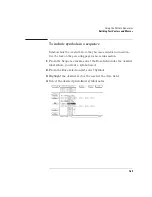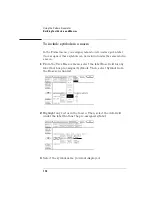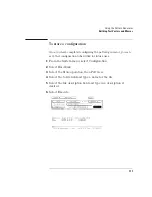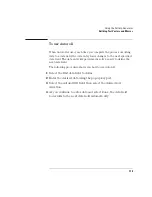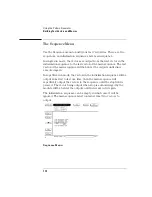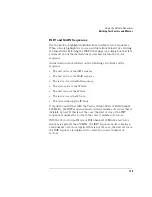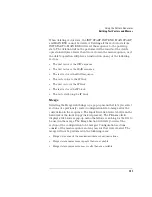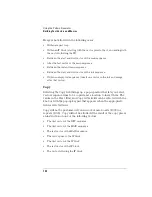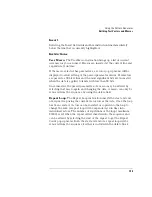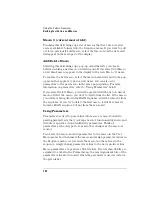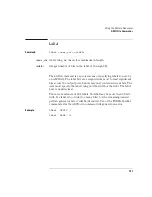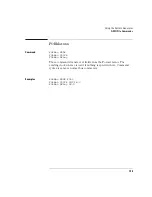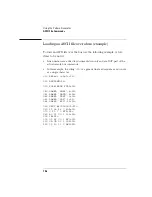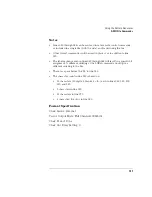
183
Using the Pattern Generator
Building Test Vectors and Macros
Insert
Selecting the Insert field adds another instruction line immediately
below the line that is currently highlighted.
Instructions
User Macro.
The User Macro instruction brings up a list of current
user macros you can insert. Macros are inserted at the current line and
expanded at run time.
If the macro selected has parameters, a second pop-up menu will be
displayed to allow setting of the passed parameter values. Parameters
are passed as 32 bit values and the most significant bits are truncated
when the data is applied to labels with less than 32 bits.
Once inserted, the passed parameters of a macro may be altered by
selecting that macro again and changing the data. A macro can only be
removed from the sequence by using the delete field.
Repeat Loop.
The Repeat Loop instruction inserts the start and end
of a repeat loop using the current vector row as the data. Once the loop
has been created, vectors can be inserted or copied into the loop to
change the size. A repeat loop will be expanded at run time into
individual vectors. The number of repetitions of the loop (maximum
20000) is set when the repeat is first inserted into the sequence and
can be altered by selecting the start of the repeat to get the Repeat
Count pop-up menu. Both the start and end of a repeat loop will be
removed from the sequence if either is included in the delete block.
Summary of Contents for 1670E Series
Page 6: ...6 In This Book...
Page 26: ...26 Contents...
Page 27: ...27 Section 1 Logic Analyzer...
Page 28: ...28...
Page 29: ...29 1 Logic Analyzer Overview...
Page 39: ...39 2 Connecting Peripherals...
Page 49: ...49 3 Using the Logic Analyzer...
Page 72: ...72 Using the Logic Analyzer The Inverse Assembler...
Page 73: ...73 4 Using the Trigger Menu...
Page 101: ...101 5 Using the Oscilloscope...
Page 151: ...151 6 Using the Pattern Generator...
Page 199: ...199 7 Triggering Examples...
Page 237: ...237 8 File Management...
Page 249: ...249 9 Logic Analyzer Reference...
Page 360: ...360 Logic Analyzer Reference The Compare Menu...
Page 361: ...361 10 System Performance Analysis SPA Software...
Page 397: ...397 11 Logic Analyzer Concepts...
Page 430: ...430 Logic Analyzer Concepts The Analyzer Hardware Oscilloscope board theory Oscilloscope board...
Page 439: ...439 12 Troubleshooting the Logic Analyzer...
Page 455: ...455 13 Specifications...
Page 471: ...471 14 Operator s Service...
Page 479: ...479 Operator s Service Troubleshooting Troubleshooting Flowchart 2...
Page 491: ...491 Section 2 LAN...
Page 492: ...492...
Page 493: ...493 15 Introducing the LAN Interface...
Page 497: ...497 16 Connecting and Configuring the LAN...
Page 506: ...506 Connecting and Configuring the LAN Connecting and Configuring the LAN...
Page 507: ...507 17 Accessing the Logic Analyzer File System Using the LAN...
Page 515: ...515 18 Using the LAN s X Window Interface...
Page 527: ...527 19 Retrieving and Restoring Data Using the LAN...
Page 539: ...539 20 Programming the Logic Analyzer Using the LAN...
Page 546: ...546 Programming the Logic Analyzer Using the LAN Programming the Logic Analyzer Using the LAN...
Page 547: ...547 21 LAN Concepts...
Page 555: ...555 22 Troubleshooting the LAN Connection...
Page 580: ...580 Troubleshooting the LAN Connection Getting Service Support...
Page 581: ...581 Section 3 Symbol Utility...
Page 582: ...582...
Page 583: ...583 23 Symbol Utility Introduction...
Page 588: ...588 Symbol Utility Introduction Symbol Utility Introduction...
Page 589: ...589 24 Getting Started with the Symbol Utility...
Page 597: ...597 25 Using the Symbol Utility...
Page 609: ...609 26 Symbol Utility Features and Functions...

